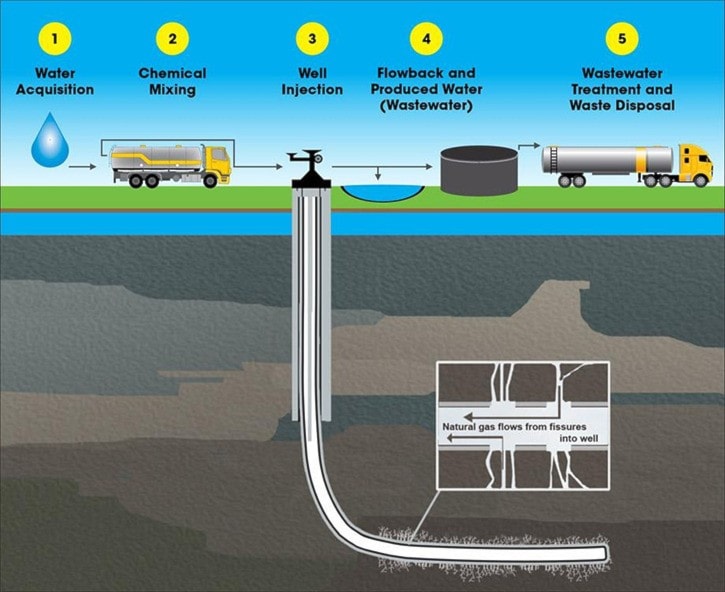The provincial government and the liquefied natural gas (LNG) industry have been pushing LNG development in B.C. by selling the idea of "clean energy" to the public.
But can LNG really be considered "clean energy"? And what are the impacts that hydraulic fracturing (fracking) can have on the environment?
Lakes District News spoke to a couple of experts to find the answers.
According to Jeff Curtis, Associate Professor of Earth and Environmental Sciences at the University of British Columbia, "cleaner" is maybe more accurate for LNG than the word "clean."
"No birds ever drown in slicks of spilled LNG as they do in oil, but spilled/leaked LNG goes directly to the atmosphere where it is an extremely potent and invisible greenhouse gas."
Curtis said the public should not confuse LNG with renewable sources of energy that tend to be much cleaner from the greenhouse gas perspective such as wind and solar.
Kevin Hanna, Director of the University of British Columbia's Centre for Environmental Assessment Research, says natural gas is the cleanest of the fossil fuels.
"The shale gas cycle has lower greenhouse gas impacts compared to coal, bitumen or conventional oil," he said.
However, Hanna points out that the production of LNG for export will greatly increase B.C.’s production of greenhouse gas and make it difficult, or even impossible, to meet essential greenhouse gas contribution targets.
"We cannot assume that LNG will replace the use of oil or coal; there is no clear policy or trade basis for that contention," he said. "But if it does replace dirtier fuels, then that would be a good thing."
The vast majority of B.C.’s natural gas resources are only accessible through the use of fracking. This is the procedure by which gas companies inject water and chemicals into the ground to fracture underlying shale rock formations and extract natural gas.
Fracking is primarily used in Northeast B.C., where the province’s shale gas plays are located – the Horn River Basin, Cordova Embayment and Liard Basin near Fort Nelson; the Montney Play area near Dawson Creek and Fort St. John.
When asked about the impacts that fracking could have on the environment, Hanna said the answer is still unclear.
“Fracking activities may impact groundwater - notably methane and chemical migration into freshwater reserves -, or may not,” he said.
The U.S. Environmental Protection Agency has produced a large analysis of existing research noting that the impacts of fracking on groundwater are “inconclusive.”
“We can interpret this to mean that impacts have not been proven, or that they have not been disproved,” said Hanna. “The study notes the need for more data, more research, and a better understanding of baseline conditions to better gauge if impacts occur.”
Hanna explained that although fracking techniques have been around for some time, the industry has only reached a significant scale in recent decades, so the long-term impacts are not well understood.
“I think at this point is reasonable to say that there are places that will not ever see groundwater impacted by fracking; some might in the future, and some might be experiencing impacts already,” he said.
In a study published earlier this year in the journal ‘Seismological Research Letters,’ scientists compared the relationship of 12,289 fracking wells and 1236 wastewater disposal wells to magnitude three or larger earthquakes near the border between Alberta and British Columbia.
The study confirmed the link between fracking and induced earthquakes recorded in Northeast B.C. According to The Globe and Mail, the number of earthquakes in Northeast B.C. jumped from about 20 a year in 2002 to nearly 200 a year by 2011.
The study confirmed that nearly all the region’s overall seismicity of magnitude three or larger has been induced by human activity - more than 60 per cent of these quakes are linked to fracking, about 30-35 per cent come from wastewater disposal wells, and only five to 10 per cent of the earthquakes have a natural tectonic origin.
Shortly after the study was published, Andrew Weaver, Leader of the B.C. Green Party, called for a moratorium on fracking until there is a better understanding of its risks.
“I am calling on both the government and the official opposition to join me in supporting a moratorium on horizontal fracking in British Columbia,” said Weaver. “Other jurisdictions, like Quebec, New York, New Brunswick and Nova Scotia, have already suspended the practice and B.C. should follow suit.”
According to the provincial government, however, the technology used for fracking is “safe and efficient.”
According to Lindsay Byers, a spokesperson with the B.C. Ministry of Natural Gas Development, industry operations in B.C. are subject to stringent regulations, as well as compliance and enforcement actions by the B.C. Oil and Gas Commission.
“British Columbia is fortunate to have a large natural-gas resource base - the world’s cleanest burning fossil fuel - to pursue global market demands as well as today’s domestic needs,” said Byers. “That is why the government of British Columbia is working to advance all available opportunities for B.C.’s natural gas sector, including LNG exports.”
The province says fracking has existed in B.C. since the 1960s, with no incidence of groundwater contamination.
